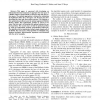Free Online Productivity Tools
i2Speak
i2Symbol
i2OCR
iTex2Img
iWeb2Print
iWeb2Shot
i2Type
iPdf2Split
iPdf2Merge
i2Bopomofo
i2Arabic
i2Style
i2Image
i2PDF
iLatex2Rtf
Sci2ools
CDC
2010
IEEE
2010
IEEE
Aggregation-based model reduction of a Hidden Markov Model
This paper is concerned with developing an information-theoretic framework to aggregate the state space of a Hidden Markov Model (HMM) on discrete state and observation spaces. The optimal aggregation is obtained by minimizing the Kullback-Leibler (K-L) divergence rate between joint laws describing the state and observation processes. The solution to this optimization problem is just the optimal aggregated Hidden Markov Model. This optimization problem is solved in two steps: The first step is to formulate the optimal solution for any fixed partition. The second step is to find the optimal partition by using an approximate dynamic programming framework. The algorithm can be implemented using a single sample path of the HMM. The convergence of the algorithm is established using standard stochastic approximation arguments and illustrated with the aid of examples.
Related Content
| Added | 13 May 2011 |
| Updated | 13 May 2011 |
| Type | Journal |
| Year | 2010 |
| Where | CDC |
| Authors | Kun Deng, Prashant G. Mehta, Sean P. Meyn |
Comments (0)

